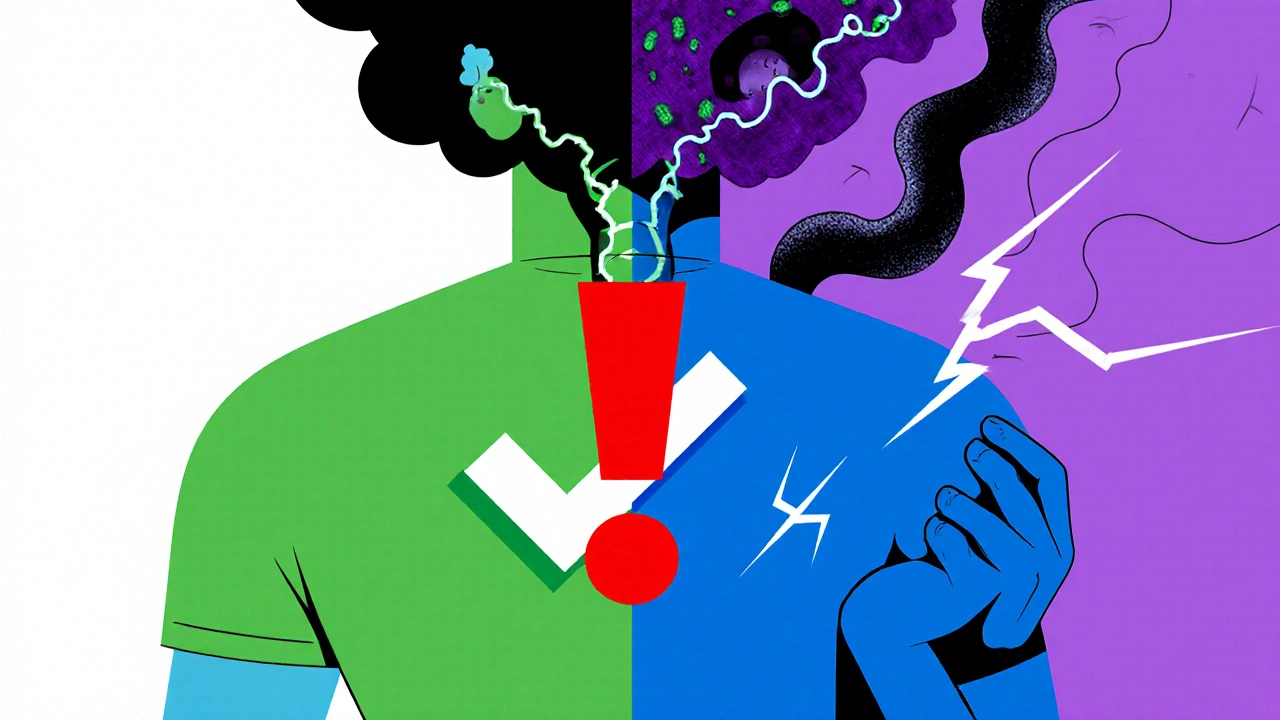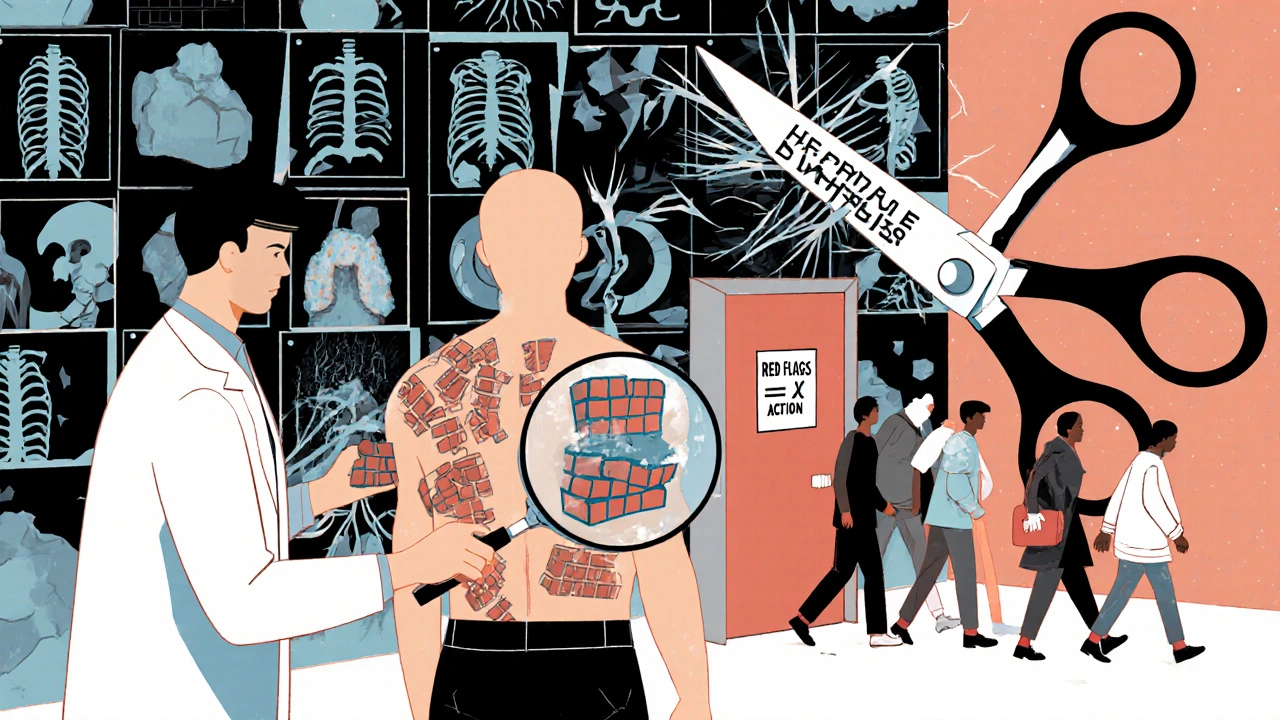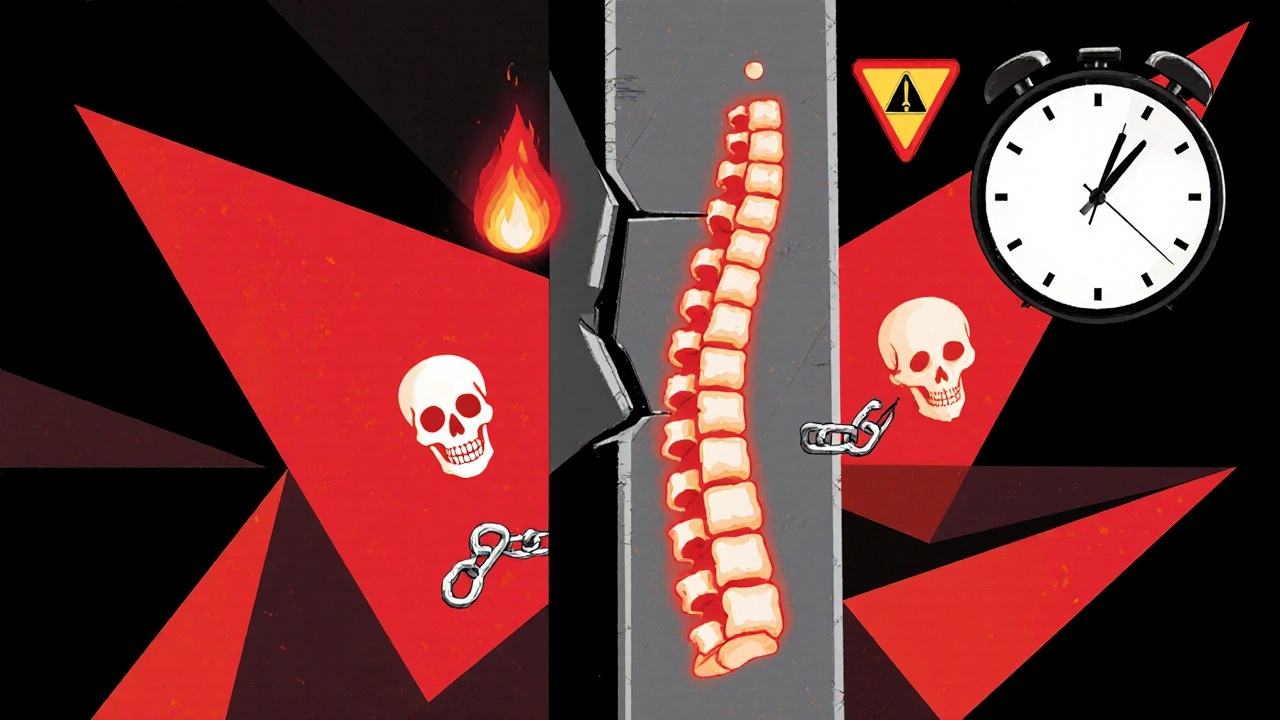Most people experience back pain at some point. It’s common, often annoying, and usually goes away on its own within a few weeks. But sometimes, back pain isn’t just a muscle strain-it could be a sign of something serious. Knowing the back pain red flags can mean the difference between waiting it out and getting life-saving care in time.
What Are Back Pain Red Flags?
Back pain red flags are warning signs that point to underlying conditions like infection, cancer, fractures, or nerve damage. These aren’t the kind of pain you can treat with ice, ibuprofen, or rest. They need immediate medical attention. The idea isn’t to scare you-it’s to help you recognize when your pain is more than just soreness. According to guidelines from the American College of Physicians and the American College of Emergency Physicians, about 90% of back pain cases are harmless and resolve without imaging or surgery. But the other 10%? That’s where things get urgent. Missing a spinal infection, a tumor pressing on nerves, or a broken vertebra can lead to permanent disability-or worse.Red Flags That Demand Immediate Action
Not all red flags are created equal. Some are clear, objective, and backed by strong evidence. Others are trickier. Here are the most critical ones:- Loss of bowel or bladder control-This is a classic sign of cauda equina syndrome. Nerves at the bottom of your spine are being compressed. If not treated within 48 hours, you could lose function permanently.
- Unexplained weight loss with back pain-Losing weight without trying, especially if you’re over 50, raises a red flag for cancer. Spinal metastases are more common than most people realize.
- Fever, chills, or recent infection-If you’ve had a urinary tract infection, skin abscess, or IV drug use and now have back pain, you could have spinal osteomyelitis. This infection eats away at bone and can spread fast.
- History of cancer-If you’ve had breast, lung, prostate, or any other cancer before, new back pain isn’t just a strain. It could be the cancer spreading to your spine.
- Severe trauma-A fall from height, car crash, or direct blow to the back, especially if you’re over 50 or have osteoporosis, means you need imaging right away.
- Progressive weakness or numbness in legs-If your foot keeps dropping, you’re dragging your leg, or your toes feel like they’re asleep, nerve damage is likely. This isn’t sciatica-it’s something more serious.
- Pain that doesn’t improve with rest or painkillers-Most mechanical back pain gets better with time and OTC meds. If it’s still burning or stabbing after a week, even with medication, something else is going on.
These aren’t guesses. Studies show that patients with these symptoms are 6 to 54 times more likely to have a serious condition than those without them. For example, a history of cancer combined with back pain has a positive likelihood ratio of up to 15.3-meaning it’s a very strong indicator.
Age Matters-And So Does Medical History
Back pain in someone under 18 or over 50 needs extra caution. Kids rarely get degenerative spine issues. If a 15-year-old has persistent back pain, it could be a tumor, infection, or structural problem. In older adults, even minor falls can cause fractures. One study found that 36.5% of people over 70 with back pain had a vertebral compression fracture-compared to just 9.1% of those under 50. If you’re on long-term steroids, have osteoporosis, or have had spinal surgery before, your risk goes up. Steroids weaken bone. Osteoporosis makes vertebrae fragile. Even a sneeze can cause a fracture in someone with severe bone loss. These aren’t just risk factors-they’re warning signs.
When Imaging Is Necessary (and When It’s Not)
Imaging-like X-rays, MRIs, or CT scans-isn’t the answer for every back pain case. In fact, getting an MRI for simple muscle strain can do more harm than good. Studies show that 34% of imaging for low back pain is unnecessary. And here’s the kicker: those scans often show “abnormalities” like disc bulges or degeneration that have nothing to do with the pain. In fact, 79% of asymptomatic 80-year-olds have degenerated discs on MRI. Seeing those results can lead to unnecessary surgeries, anxiety, and more tests. So when is imaging actually needed?- For suspected infection or tumor-MRI is the gold standard. It’s 95% sensitive for cauda equina syndrome and can detect bone marrow changes before X-rays even show damage.
- For suspected fracture-CT scans are far better than X-rays. They catch 98% of fractures in older adults, while X-rays miss up to 36%.
- For neurological deficits-If you have leg weakness, numbness, or loss of reflexes, MRI is required to see what’s pressing on the nerves.
- For persistent pain after 6 weeks-If conservative care (physical therapy, activity modification, pain management) hasn’t helped, imaging may help guide next steps.
Plain X-rays? They’re rarely useful unless you have a history of trauma, osteoporosis, or steroid use. Even then, they’re a starting point-not the final answer.
When to Refer-Not Just to a Doctor, But to the Right Specialist
Not every doctor is trained to spot red flags. Your family doctor might miss them. That’s why knowing when to refer matters.- Emergency room-Go immediately if you have bowel/bladder issues, sudden leg weakness, or fever with back pain. These are emergencies.
- Spine specialist or neurologist-If you have progressive numbness, tingling, or weakness, you need someone who understands nerve compression.
- Oncologist or infectious disease specialist-If cancer or infection is suspected, you need targeted testing, not just imaging.
- Physical therapist-For most back pain without red flags, physical therapy is more effective than pills or scans. But if red flags are present, PT should refer out-not try to treat.
Failure to refer can be dangerous. A 2021 study found that 12% of spinal malpractice cases involved delayed diagnosis of serious pathology. That’s not just a statistic-it’s someone who lost mobility, or worse, because no one connected the dots.
What About Chronic Pain?
If your back pain has lasted more than three months, it’s considered chronic. That doesn’t automatically mean cancer or infection. But it does mean it’s time to look deeper. A 2018 study found that patients whose pain didn’t improve after four weeks were nearly 20 times more likely to need surgery later. Chronic pain often comes with psychological stress, sleep loss, and depression. But before you start therapy or pain management, rule out the red flags first. You can’t treat depression if the real problem is a spinal tumor.
The Bigger Picture: Why This Matters
Overuse of imaging for back pain costs the U.S. about $3 billion a year. And it doesn’t help. People get scanned, find a bulging disc, and assume that’s the problem-then they get surgery that doesn’t fix anything. The real solution? Better screening. The Choosing Wisely campaign, backed by major medical groups, says: Don’t image low back pain without red flags. Insurance companies like Anthem now deny coverage for unnecessary scans. That’s because the evidence is clear: red flags work. A 2019 study of over 8,000 patients showed that when doctors used red flag screening properly, unnecessary imaging dropped by 28%-and not a single serious case was missed.What You Can Do Today
If you have back pain:- Ask yourself: Is this pain getting worse, not better?
- Check for fever, weight loss, or numbness in your groin or legs.
- Think: Have I had cancer? Am I over 50? Did I fall?
- If any red flags are present, don’t wait. See a doctor within 24 hours.
- If none are present, try rest, light movement, and OTC pain relief for 2-4 weeks.
Most back pain will get better. But if it doesn’t-or if something feels off-trust your gut. Your body is trying to tell you something.
Is back pain always serious if it’s severe?
No. Severe pain doesn’t automatically mean a serious condition. Many people have intense muscle spasms or herniated discs that aren’t dangerous. What matters is whether there are other red flags-like fever, weight loss, or loss of bladder control. Pain intensity alone isn’t enough to diagnose a serious issue.
Can I wait a few days if I have one red flag?
It depends on the red flag. If you have bowel or bladder problems, sudden leg weakness, or fever with back pain, don’t wait. Go to the ER immediately. For less urgent signs-like unexplained weight loss or pain that won’t go away after two weeks-see your doctor within a few days. Delaying care can let conditions like spinal infection or cancer spread.
Do I need an MRI for every case of back pain?
No. In fact, most people don’t need one at all. MRIs are only recommended when red flags are present or if pain persists beyond 6 weeks despite treatment. For most cases, physical therapy and time are more effective than scans. Unnecessary MRIs often show harmless changes that lead to anxiety and unnecessary procedures.
What if my doctor says my pain is just muscle strain but I’m still worried?
It’s okay to ask for a second opinion. If you have risk factors-like past cancer, steroid use, or age over 50-and your pain isn’t improving, push for further evaluation. Red flag screening isn’t perfect, but it’s your best tool. If you feel something’s off, trust that feeling and ask: "Could this be something more?"
Are there new ways to detect serious back pain conditions faster?
Yes. Researchers are testing tools like point-of-care ultrasound to check for bladder fullness (a sign of nerve compression) and blood tests for inflammation markers like CRP and ESR. In the future, combining these with red flag screening may cut diagnosis time for spinal infections from 18 days to under 48 hours. But right now, history and physical exam remain the most reliable tools.

Gary Hattis
November 12, 2025 AT 06:56I’ve had back pain for months after lifting a couch. Thought it was just a strain. Then one morning I couldn’t pee. Went to the ER. Turns out it was cauda equina. They had to operate within hours. If I’d waited another day, I’d be in a wheelchair now. Don’t ignore the red flags. Seriously.
It’s not paranoia-it’s survival.
Esperanza Decor
November 14, 2025 AT 06:09My dad had back pain for a year. Doctor kept saying ‘it’s just aging.’ He lost 20 pounds without trying. Finally got an MRI-spinal tumor. He’s alive because his daughter nagged him to push harder. If you feel something’s off, keep pushing. Doctors aren’t mind readers.
And yes, even if you’re ‘just’ over 50. That’s not a weakness. It’s a warning label.
Deepa Lakshminarasimhan
November 16, 2025 AT 03:52They say 90% of back pain is harmless. But what if you’re in the 10% and they miss it? I’ve seen people get scanned for ‘disc bulges’ and then get surgery that made it worse. Meanwhile, the real problem-like a hidden infection-goes undetected because no one checked for fever or weight loss.
They’re selling scans like candy. Insurance denies them now? That’s because they’re profitable, not because they’re helpful. Who’s really benefiting here?
Erica Cruz
November 17, 2025 AT 05:42Let’s be real-this whole ‘red flag’ thing is just a way for specialists to justify their existence. You don’t need a neurologist to know if you can’t pee. And if you’re over 50 and have back pain, you’re automatically a cancer suspect? That’s fearmongering wrapped in medical jargon.
Most of these ‘red flags’ are just normal human biology. You’re telling me a 52-year-old who lost 5 pounds and has a sore back needs an MRI? No. They need to stop watching medical dramas and go for a walk.
Johnson Abraham
November 18, 2025 AT 01:23bro i had back pain after lifting my dog and i went to the er bc i read this article and they laughed at me. said i had a pulled muscle. i was like ‘but what if its cancer??’ they gave me ibuprofen and a sticker. now i dont trust doctors. also why is everyone so scared of disc bulges?? they’re just like wrinkles but for your spine 😅
also i think the real red flag is doctors overtesting people. just let people rest. we’re not broken machines.
Shante Ajadeen
November 18, 2025 AT 09:19This is the kind of info everyone needs to see. I used to think back pain was just something you ‘toughed out.’ Now I know it’s not about being tough-it’s about being smart.
My cousin ignored her pain for months because she didn’t want to miss work. Turned out she had a spinal infection. She’s fine now, but she was in the hospital for three weeks. Please, if you’re reading this and you’re hurting-listen to your body. Don’t be like me and wait too long.
dace yates
November 20, 2025 AT 06:53What about people with chronic pain who’ve had multiple negative scans? Does that mean their pain isn’t real? I’ve been told ‘nothing’s wrong’ five times. I still can’t sit for more than 10 minutes. Is there a red flag for when the system fails you?
Danae Miley
November 20, 2025 AT 09:29The article correctly emphasizes that imaging should be reserved for red flags-but fails to mention that red flag screening is only as good as the clinician’s training. A 2023 JAMA study showed that 62% of primary care physicians misidentify at least two key red flags. This isn’t a patient problem-it’s a systemic one.
Education, not just guidelines, is the missing piece.
Charles Lewis
November 21, 2025 AT 16:54As someone who has spent over two decades in clinical practice, I can say with certainty that the most dangerous misconception in modern medicine is the belief that ‘if it’s not cancer, it’s nothing.’ Back pain is a symptom, not a diagnosis. The red flags outlined here are evidence-based, clinically validated, and-most importantly-life-preserving.
Yet, we continue to see patients referred too late because they were told to ‘wait and see’ or because their provider dismissed their concerns as ‘anxiety.’ This is not a failure of patient compliance. This is a failure of clinical vigilance.
Let us not mistake the rarity of serious pathology for the insignificance of its consequences. One missed diagnosis can alter a life forever. The data is clear. The guidelines are clear. The moral imperative is clear.
Act early. Refer early. Listen deeply. And never, ever confuse common with harmless.